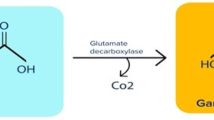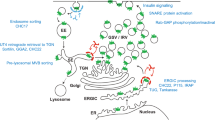Abstract
Animal aspartate decarboxylase (ADC), glutamate decarboxylase (GDC) and cysteine sulfinic acid decarboxylase (CSADC) catalyze the decarboxylation of aspartate, glutamate and cysteine sulfinic acid to β-alanine, γ-aminobutyric acid and hypotaurine, respectively. Each enzymatic product has been implicated in different physiological functions. These decarboxylases use pyridoxal 5-phosphate (PLP) as cofactor and share high sequence homology. Analysis of the activity of ADC in the presence of different amino determined that beta-alanine production from aspartate was diminished in the presence of cysteine. Comparative analysis established that cysteine also inhibited GDC and CSADC in a concentration-dependent manner. Spectral comparisons of free PLP and cysteine, together with ADC and cysteine, result in comparable spectral shifts. Such spectral shifts indicate that cysteine is able to enter the active site of the enzyme, interact with the PLP-lysine internal aldimine, form a cysteine-PLP aldimine and undergo intramolecular nucleophilic cyclization through its sulfhydryl group, leading to irreversible ADC inactivation. Cysteine is the building block for protein synthesis and a precursor of cysteine sulfinic acid that is the substrate of CSADC and therefore is present in many cells, but the presence of cysteine (at comparable concentrations to their natural substrates) apparently could severely inhibit ADC, CSADC and GDC activity. This raises an essential question as to how animal species prevent these enzymes from cysteine-mediated inactivation. Disorders of cysteine metabolism have been implicated in several neurodegenerative diseases. The results of our study should promote research in terms of mechanism by which animals maintain their cysteine homeostasis and possible relationship of cysteine-mediated GDC and CSADC inhibition in neurodegenerative disease development.










Similar content being viewed by others
References
Abbott EH, Martell AE (1970) Pyridoxine and pyridoxal analogs. 13. A nuclear magnetic resonance study of the condensation of polyfunctional amino acids with pyridoxal. J Am Chem Soc 92(6):1754–1759
Andine P, Orwar O, Jacobson I, Sandberg M, Hagberg H (1991) Extracellular acidic sulfur-containing amino acids and gamma-glutamyl peptides in global ischemia: postischemic recovery of neuronal activity is paralleled by a tetrodotoxin-sensitive increase in cysteine sulfinate in the CA1 of the rat hippocampus. J Neurochem 57(1):230–236
Arakane Y, Lomakin J, Beeman RW, Muthukrishnan S, Gehrke SH, Kanost MR, Kramer KJ (2009) Molecular and functional analyses of amino acid decarboxylases involved in cuticle tanning in Tribolium castaneum. J Biol Chem 284(24):16584–16594. doi:10.1074/jbc.M901629200
Artioli GG, Gualano B, Smith A, Stout J, Lancha AH Jr (2010) Role of beta-alanine supplementation on muscle carnosine and exercise performance. Med Sci Sports Exerc 42(6):1162–1173. doi:10.1249/MSS.0b013e3181c74e38
Bellia F, Vecchio G, Cuzzocrea S, Calabrese V, Rizzarelli E (2011) Neuroprotective features of carnosine in oxidative driven diseases. Mol Aspects Med 32(4–6):258–266. doi:10.1016/j.mam.2011.10.009
Bourdon E, Loreau N, Lagrost L, Blache D (2005) Differential effects of cysteine and methionine residues in the antioxidant activity of human serum albumin. Free Radical Res 39(1):15–20
Buell MV, Hansen RE (1960) Reaction of pyridoxal-5-phosphate with aminothiols. J Am Chem Soc 82(23):6042–6049
Coyle JT, Puttfarcken P (1993) Oxidative stress, glutamate, and neurodegenerative disorders. Science 262(5134):689–695
Diaz-Arrastia R (2000) Homocysteine and neurologic disease. Arch Neurol 57(10):1422–1427
Droge W (2005) Oxidative stress and ageing: is ageing a cysteine deficiency syndrome? Philos Trans R Soc Lond B Biol Sci 360(1464):2355–2372. doi:10.1098/rstb.2005.1770
Foos TM, Wu JY (2002) The role of taurine in the central nervous system and the modulation of intracellular calcium homeostasis. Neurochem Res 27(1–2):21–26
Grossfeld RM (1985) Inhibition of crayfish glutamic acid decarboxylase by structural analogs of the substrate and product. Comp Biochem Physiol C Comp Pharmacol Toxicol 81(2):471–478
Hama T, Tamaki N, Kita M, Iizumi H (1971) Contents of beta-alanine, anserine and carnosine in silkworm and the effect of beta-alanine administration. Seikagaku J Jpn Biochem Soc 43(5):293–298
Han Q, Gao YG, Robinson H, Li J (2008) Structural insight into the mechanism of substrate specificity of aedes kynurenine aminotransferase. Biochemistry 47(6):1622–1630. doi:10.1021/bi701800j
Han Q, Robinson H, Cai T, Tagle DA, Li J (2009) Structural insight into the inhibition of human kynurenine aminotransferase I/glutamine transaminase K. J Med Chem 52(9):2786–2793. doi:10.1021/jm9000874
Hardie RC (1987) Is histamine a neurotransmitter in insect photoreceptors? J Comp Physiol A 161(2):201–213
Hayes KC, Sturman JA (1981) Taurine in metabolism. Annu Rev Nutr 1:401–425. doi:10.1146/annurev.nu.01.070181.002153
Heafield MT, Fearn S, Steventon GB, Waring RH, Williams AC, Sturman SG (1990) Plasma cysteine and sulfate levels in patients with motor-neuron, Parkinson’s and Alzheimer’s-disease. Neurosci Lett 110(1–2):216–220
Heyl D, Harris SA, Folkers K (1948) The chemistry of vitamin B6. VI. Pyridoxylamino acids1. J Am Chem Soc 70(10):3429–3431
Hildebrandt W, Kinscherf R, Hauer K, Holm E, Droge W (2002) Plasma cystine concentration and redox state in aging and physical exercise. Mech Ageing Dev 123(9):1269–1281
Hipkiss AR (2009) Carnosine and its possible roles in nutrition and health. Adv Food Nutr Res 57:87–154. doi:10.1016/S1043-4526(09)57003-9
Holmes RP, Goodman HO, Shihabi ZK, Jarow JP (1992) The taurine and hypotaurine content of human semen. J Androl 13(3):289–292
Hopkins TL, Morgan TD, Kramer KJ (1984) Catecholamines in hemolymph and cuticle during larval, pupal and adult development of Manduca sexta (L). Insect Biochem 14(5):533–540
James SJ, Cutler P, Melnyk S, Jernigan S, Janak L, Gaylor DW, Neubrander JA (2004) Metabolic biomarkers of increased oxidative stress and impaired methylation capacity in children with autism. Am J Clin Nutr 80(6):1611–1617
Kramer KJ, Morgan TD, Hopkins TL, Roseland CR, Aso Y, Beeman RW, Lookhart GL (1984) Catecholamines and beta-alanine in the red flour beetle, Tribolium castaneum—roles in cuticle sclerotization and melanization. Insect Biochem 14(3):293–298
Lehmann A (1987) Alterations in hippocampal extracellular amino acids and purine catabolites during limbic seizures induced by folate injections into the rabbit amygdala. Neuroscience 22(2):573–578
Lehmann A, Hagberg H, Orwar O, Sandberg M (1993) Cysteine sulphinate and cysteate: mediators of cysteine toxicity in the neonatal rat brain? Eur J Neurosci 5(10):1398–1412
Liu P, Ding H, Christensen BM, Li J (2012) Cysteine sulfinic acid decarboxylase activity of Aedes aegypti aspartate 1-decarboxylase: the structural basis of its substrate selectivity. Insect Biochem Mol Biol
McCaddon A, Davies G, Hudson P, Tandy S, Cattell H (1998) Total serum homocysteine in senile dementia of Alzheimer type. Int J Geriatric Psych 13(4):235–239
McCoy JG, Bailey LJ, Bitto E, Bingman CA, Aceti DJ, Fox BG, Phillips GN Jr (2006) Structure and mechanism of mouse cysteine dioxygenase. Proc Natl Acad Sci USA 103(9):3084–3089. doi:10.1073/pnas.0509262103
Miki H, Funato Y (2012) Regulation of intracellular signalling through cysteine oxidation by reactive oxygen species. J Biochem 151(3):255–261. doi:10.1093/Jb/Mvs006
Morgan TD, Hopkins TL, Kramer KJ, Roseland CR, Czapla TH, Tomer KB, Crow FW (1987) N-beta-alanylnorepinephrine—biosynthesis in insect cuticle and possible role in sclerotization. Insect Biochem 17(2):255–263
Moussian B (2010) Recent advances in understanding mechanisms of insect cuticle differentiation. Insect Biochem Mol Biol 40(5):363–375. doi:10.1016/j.ibmb.2010.03.003
Olanow CW (1993) A radical hypothesis for neurodegeneration. Trends Neurosci 16(11):439–444
Oliveira EF, Cerqueira NM, Fernandes PA, Ramos MJ (2011) Mechanism of formation of the internal aldimine in pyridoxal 5′-phosphate-dependent enzymes. J Am Chem Soc 133(39):15496–15505. doi:10.1021/ja204229m
Olney JW, Zorumski C, Price MT, Labruyere J (1990) l-cysteine, a bicarbonate-sensitive endogenous excitotoxin. Science 248(4955):596–599
Percudani R, Peracchi A (2003) A genomic overview of pyridoxal-phosphate-dependent enzymes. EMBO Rep 4(9):850–854. doi:10.1038/sj.embor.embor914
Porter TG, Martin DL (1987) Rapid inactivation of brain glutamate decarboxylase by aspartate. J Neurochem 48(1):67–72
Richardson G, Ding H, Rocheleau T, Mayhew G, Reddy E, Han Q, Christensen BM, Li J (2010) An examination of aspartate decarboxylase and glutamate decarboxylase activity in mosquitoes. Mol Biol Rep 37(7):3199–3205. doi:10.1007/s11033-009-9902-y
Schonbeck ND, Skalski M, Shafer JA (1975) Reactions of pyrzdoxal 5′-phosphate, 6-aminocaproic acid, cysteine, and penicillamine. Models for reactions of Schiff base linkages in pyridoxal 5′-phosphate-requiring enzymes. J Biol Chem 250(14):5343–5351
Schuttelkopf AW, van Aalten DM (2004) PRODRG: a tool for high-throughput crystallography of protein–ligand complexes. Acta Crystallogr D Biol Crystallogr 60(Pt 8):1355–1363. doi:10.1107/S0907444904011679
Smith AE, Walter AA, Graef JL, Kendall KL, Moon JR, Lockwood CM, Fukuda DH, Beck TW, Cramer JT, Stout JR (2009) Effects of beta-alanine supplementation and high-intensity interval training on endurance performance and body composition in men; a double-blind trial. J Int Soc Sports Nutr 6:5. doi:10.1186/1550-2783-6-5
Smith AE, Stout JR, Kendall KL, Fukuda DH, Cramer JT (2011) Exercise-induced oxidative stress: the effects of beta-alanine supplementation in women. Amino Acids. doi:10.1007/s00726-011-1158-x
Stipanuk MH (2004) Role of the liver in regulation of body cysteine and taurine levels: a brief review. Neurochem Res 29(1):105–110
Stipanuk MH, Londono M, Lee JI, Hu M, Yu AF (2002) Enzymes and metabolites of cysteine metabolism in nonhepatic tissues of rats show little response to changes in dietary protein or sulfur amino acid levels. J Nutr 132(11):3369–3378
Stipanuk MH, Dominy JE Jr, Lee JI, Coloso RM (2006) Mammalian cysteine metabolism: new insights into regulation of cysteine metabolism. J Nutr 136(6 Suppl):1652S–1659S
Stuart AE, Borycz J, Meinertzhagen IA (2007) The dynamics of signaling at the histaminergic photoreceptor synapse of arthropods. Prog Neurobiol 82(4):202–227. doi:10.1016/j.pneurobio.2007.03.006
Trott O, Olson AJ (2010) AutoDock Vina: improving the speed and accuracy of docking with a new scoring function, efficient optimization, and multithreading. J Comput Chem 31(2):455–461. doi:10.1002/jcc.21334
Zecca L, Youdim MB, Riederer P, Connor JR, Crichton RR (2004) Iron, brain ageing and neurodegenerative disorders. Nat Rev Neurosci 5(11):863–873. doi:10.1038/nrn1537
Acknowledgments
The authors thank Dr. Pablo Sabrado (Virginia Tech) for the use of Aligent 8453 UV/visible Spectrophotometer. This work is supported by NIH grant AI 19769.
Author information
Authors and Affiliations
Corresponding author
Electronic supplementary material
Below is the link to the electronic supplementary material.
726_2012_1342_MOESM1_ESM.docx
Supplemental figure 1. Prolonged pre-incubation of cysteine with AeADC could completely inactivate the ADC activity of the enzyme. 2 μg AeADC and 1 mM of cysteine in 200 mM phosphate buffer pH=7.5 were incubated for 10 min at 25 oC prior to adding 5 mM of aspartate. The total reaction volume was 50 μl. The production of β-alanine was measured at 10 min after adding aspartate at 25 oC (DOCX 36 kb)
726_2012_1342_MOESM2_ESM.docx
Supplemental figure 2. Spectrum of supernatant from heat-denatured AeADC sample. Purified AeADC was concentrated to 10 mg per ml and treated with 2 mM of cysteine for 30 min. The treated sample was then separated by gel filtration chromatography to separate the enzyme from free cysteine. The collected protein fraction was heat-denatured and the supernatant was collected by centrifugation. The spectral characteristics of the supernatant were then analyzed using Hitachi U-2008 spectrophotometer (DOCX 88 kb)
726_2012_1342_MOESM3_ESM.docx
The model of AeADC predicted the relative positions of substrate and Q377. A. The relative position of cysteine sulfinic acid and Q377 at the active site of predicted AeADC structure. B. The relative position of aspartate and Q377 at the active site of predicted AeADC structure (DOCX 1542 kb)
Rights and permissions
About this article
Cite this article
Liu, P., Torrens-Spence, M.P., Ding, H. et al. Mechanism of cysteine-dependent inactivation of aspartate/glutamate/cysteine sulfinic acid α-decarboxylases. Amino Acids 44, 391–404 (2013). https://doi.org/10.1007/s00726-012-1342-7
Received:
Accepted:
Published:
Issue Date:
DOI: https://doi.org/10.1007/s00726-012-1342-7




